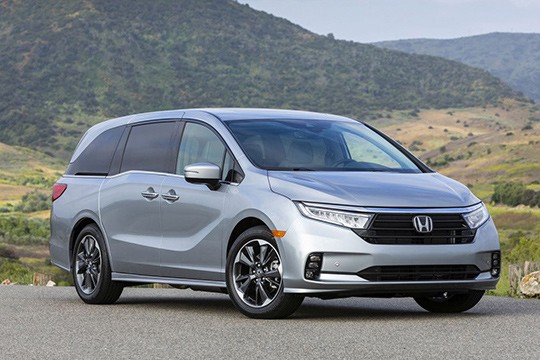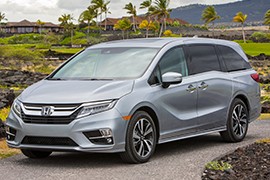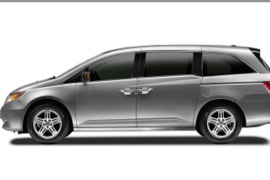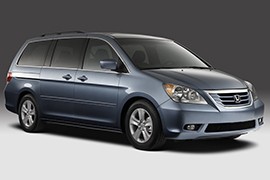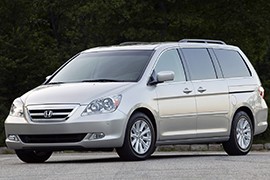HONDA Odyssey Models/Series Timeline, Specifications & Photos
First production year: 2005
Engines: Gasoline
Body style: Van
The fifth generation of the big MPV from Honda was introduced on the market in 2018 and, in 2020, it went through a mid-life cycle refresh.
The first generation of the Odyssey was introduced in 1995 and it was a great addition to a market hungry for innovative minivans. It was different in a good way and soon it became a desirable car for the North-American MPV market.
The 2020 facelift brought a new bumper design, with a slimmer lower grille. The headlights followed the same design style as the Honda Accord or the Civic. It was unusual to see an MPV with such an aggressive stance. On the sides, the sculptured door panels resembled those installed on the FCX Clarity hydrogen car. The D-pillars featured a black area that visually led to a floating-roof design.
Inside, the Odyssey was fitted with room for up to eight passengers. The middle row was sliding, tilting, or have the center seat removed, leading to a wider room for the occupants and creating a passage through to the rear seats. The car was fitted with a new option, named CabinWatch, which warned the driver if someone was still on the rear seats.
Under the hood, the Odyssey was fitted with the same 3.5-liter i-VTEC engine as before and it was mated to the new, 10-speed, automatic transmission available on the Honda Accord as well. Unlike the Accord, the Odyssey was not available with the new 2.0-liter turbocharged unit.
Honda launched the fifth generation of its full-size minivan, Oddysey, in 2017 at the North American International Auto Show and continued the success story of this family-friendly MPV.
The Odyssey nameplate has been a successful story ever since the model’s introduction in 1994. Its capability to transport seven or eight passengers comfortably made it a darling for large families.
Even though it didn’t sell on all the markets and had plenty of engine versions, it was praised for its qualities as a smooth, long-distance cruiser. In addition, the overall exterior look was pleasant always up to date in terms of design trends.
For the 2018 model year, the Odyssey had a front fascia that followed the same design language as the Honda Accord or the CR-V, featuring a chromed horizontal slat on the grille and swept-back headlights. The front bumper was extended downward with an apron that also contained a secondary trapezoidal-shaped grille flanked by a pair of divided scoops for the fog lamps.
From its profile, the sculptured door panels created a dynamic image for the vehicle, while the waistline was lowered behind the rear doors. At the back, Honda’s designers made a tailgate slightly tilted forward to create more room inside the cabin.
Accessing the interior of the Odyssey was easy, thanks to the large front doors and the sliding rear doors on both sides. The front occupants were spoiled with high-mounted seats fitted with flip-down armrests and separated by a wide center console that housed a pair of cup holders and a storage compartment. Still, the automaker left some room between the center console and the center stack to allow passengers to pass from side to side.
In front of the driver, Honda installed a digital instrument cluster split into three screens, similar to the one offered in the Civic’s tenth generation, and atop the center stack, it placed the 8-inch infotainment touchscreen that featured a volume turning knob. The middle row could be tilted forward to ease access for the third-row passengers, and all of the individual seats from there could have been removed. With the middle seat removed, the outboard ones could slide inward. Even the third row was fit for adults, which made the Odyssey an excellent people carrier.
Under the hood, Honda installed a 3.5-liter gasoline engine that offered 280 hp (283 PS). It was paired with a standard nine-speed automatic transmission for the lower grades, while the upper ones were fitted with a ten-speed automatic gearbox.
The independent suspension in all corners made the Odyssey a comfortable vehicle on long distances, and the aerodynamic shape helped it get better fuel efficiency. As for the safety systems, the minivan came fitted with the entire Honda sensing package that included automatic emergency braking, adaptive cruise control, lane keep assist, and others.
The biggest minivan from Honda received a new generation in 2010, badged as a 2011 model. It was the fourth generation of the Odyssey journey and the premiere took place at the Chicago Auto Show. The features shown on the car convinced over 100.000 customers every year until the model change in 2017, in all four trim levels.
The 5.154 mm (202.9 in) long car had room for 7 people, two sliding doors and a big trunk, which could be increased by folding or removing two seat rows. The new infotainment system included a voice-controlled XM-NavTraffic system with on-board HDD.
New for the fifth generation of the Odyssey were also the headlights, which featured HID Xenon bulbs. In the rear, a power-activated tailgate was available as an option. For the upper trim levels, Honda installed 18” light-alloy wheels and an infotainment unit with a split-screen rear-seats DVD entertainment system. Also, a multi-zone climate control system was offered, but no AWD function for either variants.
Under the hood, there was the 3.5-liter gasoline V6 engine, borrowed and tuned for minivan use from the Honda Pilot SUV. It offers 255 hp and 339 Nm (250 lb.-ft) of torque. The only transmission offered was a 5-speed automatic, with front-wheel-drive. The Touring trim model was equipped with a 6-speed automatic transmission.
The third generation of the Odyssey was introduced in 2005 and it used big engineering improvements in terms of materials and body engineering. Three years later the MPV was improved.
For the 2008 model, the Odyssey received a mild update. The mid-life cycle refresh was needed since the car-market started to collapse due to the world economic crisis. To keep its customers closer, the car was better equipped than the non-facelifted version.
From the outside, there were minor changes to the headlights and the grille. In the back, a new set of taillights was introduced, to enhance both the safety and the overall image of the car. The Odyssey was offered with power sliding doors and power tailgate on the options list.
The biggest changes were inside the cabin. A new instrument cluster and a slightly different dashboard design were introduced. For all trim levels, there was a new AUX-in jack fitted as standard. While on the non-facelifted version the back-up camera was available only if the car was fitted with a navigation system, after the facelift the display for that was integrated into the rear-view mirror.
For the drivetrain, the Odyssey kept the V6 engine but enhanced. It now was available with cylinder deactivation for 2 and 3 cylinders instead of 3 as before. The transmission remained the same, with 5-speed.
The third generation of the Honda Odyssey was introduced in 2004 as a 2005 model-year. It was a successful minivan fit for up to seven passengers.
The concept of a family premium MPV didn't exist, so Honda had to create it with the introduction of the Odyssey in 1994. It wasn't the first MPV built by the Japanese car-maker, but it was the first that featured luxury amenities for that time, and it continued to improve over time.
The 2005 model showed no slowing down in upgrading a car that was already very appreciated on the market. Its new front design resembled the Honda Pilot SUV, but the rest was a completely new vehicle. Its lower bumpers made the car more compatible with the newest crash-test requirements and it was one of the safest cars on the road. In the rear, the Odyssey featured two sliding doors fitted as standard.
Inside, the new Touring trim level added leather to the seven-seat interior. New features with a navigation system and premium sound transformed the family minivan into a premium vehicle fit for seven. The folding and removing layout allowed a cargo capacity fit for a light commercial vehicle.
The Odyssey was offered with a 3.5-liter V6 mated as standard to a 5-speed automatic transmission. It was not the most evolved gearbox on the market, but it scored good points in the reliability factor. In fact, the Odyssey was one of the vehicles that hold well its value over time. Its high-strength chassis made the car stiffer than a regular Honda Accord, which was unusual for an MPV. The third generation of the Odyssey received a facelift in 2010.
